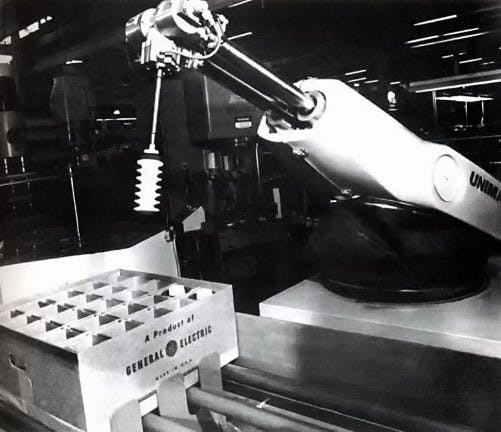The first mass produced industrial robot occurred in 1961 with the Unimate. Equipped with a 4,000-pound capacity robot arm which followed step-by-step commands stored on a magnetic drum, the Unimate originally automated the manufacture of TV picture tubes. Other applications of this robot include stacking hot pieces of die cast metal.
Industrial Robot Safety
Over the past forty years, industrial robot use has increased substantially and there are an estimated 2.7 million industrial robots currently in use worldwide. This article covers industrial robots, which are defined as an automatically controlled, reprogrammable multipurpose manipulators that are programmable in three or more axes which may be either fixed in place or mobile for use in industrial automation applications. In addition to industrial applications, robots are also used in undersea and space applications, tele-operated manipulators, prosthetics and other aids for the handicapped, micro-robots (movement less than 1 millimeter), autonomous mobile robots, and surgery.
The advantages of industrial robots performing work tasks as opposed to human workers include: consistency and precision (the writer’s experience with industrial spot welding is the robot’s ability to make a weld within 1/100th of an inch of the specified location), speed, durability (as opposed to human fatigue), resistance to job hazards (including flying pieces and particles, hot surfaces, and sharp objects), and strength/power.
The hazards frequently associated with robot operation in a work area where human workers are also present include: being struck by moving robot components, caught between a moving robot and a stationary object, and exposure to flying sparks and pieces and other hazards created by the operation performed by a robot.
Specific safety requirements for industrial robot design, installation, and operation of robots can be found in the “American National Standard for Industrial Robots and Robot Systems – Safety Requirements” published by the American National Standards Institute/Robot Industries Association (ANSI/RIA R15.06). The first edition of this standard was published in 1986 and was most recently updated in 2014.
The basic concept of protection for personnel who work with or near industrial robots is creating an operating cell or restricted space which is the maximum space or envelope that a particular robot can travel. The objective is to create effective barriers or safeguarding around the robot’s entire restricted space. Depending on the specific application, safeguards may be a physical barrier, interlocked perimeter guards, an awareness barrier, and/or a presence-sensing device (including light curtains, pressure-sensitive floor mats, electronic area monitors, etc.) that detects a person approaching the restricted space. In addition, the Standard specifies both electronic or programmed stops, and hard (mechanical) stops that limit a robot’s range of motion during normal operation.
Additional safeguards built into a robot’s electronic control system include control reliability. Control reliable safety circuitry is designed so that any single component failure does not prevent the stopping action of the robot. The circuits are also monitored to continuously check for circuit system faults. When a fault is detected, the monitoring system automatically triggers a warning and brings the robot to a safe state – including shutdown.
The barriers and safeguards are applicable when a robot is operating at a normal speed during production. However, other protective measures are required when personnel must be present within the robot’s restricted area during maintenance and robot programming or teaching operations. In addition to lockout/tagout (LO/TO) procedures, personnel must be present with the robot during times when a robot is “taught” a new or revised work operation. As opposed to normal operating speed when a robot is operating in production mode, when personnel are present within the restricted space for teaching or trouble-shooting activities when the robot must operate under power, the robot’s speed must be reduced to slow speed, which is typically 10 percent of normal speed.
During teach mode, the robot travels at 1/10th normal speed and the human who controls the robot must use controls located on a teach pendant connected to the robot. The teach pendant includes an emergency stop (e-stop) button. The slower robot speeds allow the individual holding the teach pendant greater reaction time to precisely guide robot motions and stop robot movement quickly (using the e-stop) if necessary.
Design of safety features for each robot installation requires a machine guarding assessment to ensure potential hazards have been identified and addressed. In addition to the safety measures described earlier, an effective robot safety program also includes equipment-specific training for robot programmers and maintenance personnel, a verification procedure for robot operating programs before a robot is released for production, and safety signage and warnings posted on the perimeter of the robot’s restricted space.
APTIM. In Pursuit of Better.
